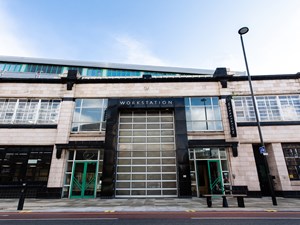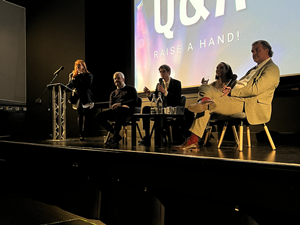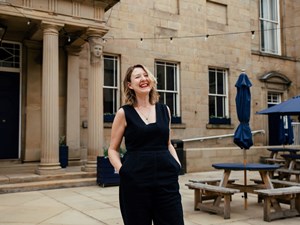Creative Network - Barnsley
Optimism and realism for audience engagement
Thursday 14 July 2022
Barnsley Civic - Barnsley
Both optimism and realism filled the room at the Barnsley SYCCIN event in July. With around 45 people in attendance in The Civic, Barnsley, the questions flowed throughout and the examples of inspiring work happening right across South Yorkshire were plentiful.
Hosted by independent arts consultant Pamela Johnson, who has an extensive career in audience engagement, it was the perfect opportunity to discuss that very subject! The evening featured a keynote talk from Oliver Mantell, Director of Evidence and Insight at The Audience Agency. There were also inspiring updates on projects to engage audiences from Anthony Baker, CEO at The Civic; Liane Holdsworth, Programme Development Manager at Barnsley Council; and Rob Hindle, Senior Area Education Manager at WEA.
“It’s a complex jigsaw of opportunity”
Anthony Baker gave a venue’s perspective on audience and programme development. He explained that The Civic is looking to engage with audiences differently to attract and retain new, younger audiences - specifically the under 30s. “We have been on a really interesting journey in the 12 years since we've been open. But going forward, we're going to change our programme, our profile and what we stand for is going to be different.”
This will include asking audiences what they want and need from the venue, he added. “We've got to really understand what the audience of this place is. We’re a major institution for the borough of Barnsley. We’ve already started this process throughout our programmes and we’re talking to thousands of people across Barnsley. It's expensive and it's time consuming. But it's the only way we'll be able to grow, deliver and change.
“Audiences are the citizens of this place and we need to be at the heart of the citizens’ experience in this borough as well. Our job is to inspire the people that live here, and hopefully also bring people into Barnsley. This is so that Barnsley can be a place for people to stay and grow - bringing and learning new skills. It’s a complex jigsaw of opportunity.”
Talking about engaging with younger audiences, Anthony added it is crucial to the future of the venue and the borough that the under 30s are part of shaping the town’s opportunities. “We need to be inspirational as a place and also raise aspirations,” he shared.
Anthony also updated the audience on The Civic’s major redevelopment programme to open up the building more, so it’s easier to access and central to the new town centre, which has recently undergone major re-development. “We’re going to have our doors wide open to the public and also have a lovely cafe/bar/restaurant for people to enjoy while seeing what else is on offer inside our building. People will be able to see that they’re getting their Civic back.”
Delving into data to get “a really rich picture of audiences”
Discussing data and insight of audience engagement, Oliver Mantell shared what he described as “the pandemic story” across the cultural sector. The agency has been doing a study funded by the Arts Humanities Research Council with various academics, looking at audiences through COVID via a population survey. “That's given us a really rich picture of audiences all the way through,” he explained.
He showed the audience a graph of audience ticket sales, which demonstrated how this flatlined in March 2020 and, aside from a few blips, stayed low until 2021. While it’s picked up again since February this year, he said some venues were anecdotally saying that wasn’t the case across the whole of the sector.
“I think we're all familiar with that idea of once lockdown happened, everyone made a dash towards doing digital stuff, with organisations pushing things online and people taking up hobbies that they maybe haven't done for ages. Surprisingly, that wasn't as widespread as it probably felt at the time. For those who are interested in the arts, it was probably quite visible. But actually we don't think it really increased the range of people attending culture and arts particularly hugely.”
In 2021, online participatory events and things to do at home ‘held steady’ before in person grew but by autumn, the amount people engaged online dropped off again, he explained. “The experience of Covid seems to have changed attitudes towards engagement. Lots of people are saying they still want to engage digitally, as well as engaging in person, but it's not a direct swap,” he added.
Oliver highlighted three key take outs from the findings: a widening of inequalities; engagement growing for those already interested in arts and culture; and ‘localism.’ “Engagement is very strongly linked to inequality, particularly when we're talking about stuff that's ticketed, or expensive or institutional or otherwise publicly funded in many cases,” he said.
“We also found that people widely coming out to visit arts and heritage sites were, by and large, younger, those with motivation already due to their interests, people living in cities and also families. People have also said that they expect to continue to attend things more locally than they did before the pandemic.
“In particular across South Yorkshire, we found that there were large numbers of culturally engaged audience members from higher income affluent areas who were keen to attend events in bigger towns and cities previously but who are now showing signs of staying more locally for their culture.
“That's obviously a real threat for all sorts of different organisations, it suggests a bit of a shift towards the more contemporary kind of products. In terms of who is engaging, it means we need to be in quite a dialogue with who is interested in what and agreeing how we present it - because it may not be what we are previously used to.”
“Come with us on this journey”
“When I inherited the beginning of the project, every single penny of its £3.4million was for capital works - pure bricks and mortar. There were no people in it and that needed to change, ” Liane Holdsworth opened with as she explained about a project currently underway to engage younger audiences in Goldthorpe.
“We wanted to engage young people in the renovation of this 1923 building as a cultural and community space,” she said. Goldthorpe is a former mining town in the Dearne Valley which was given £21.3m in funding via a Stronger Towns project, which will fund several projects for the area. One of these is set to create a cultural and community hub within the town’s Dearne Playhouse.
Liane shared how, after initial worries from community members, they too started to understand the importance of getting kids to utilise the building for the future of the town. “So we really needed to get to know the young people in the area,” she said.
After getting match funding in collaboration with the university of Sheffield, Liane explained how a programme to engage the younger generations was initiated. “We decided to go out and really work with young people. We asked them their story with no holds barred. We asked ‘What do you want to tell us? How do you want to tell it and who do you want to tell it to?’ Importantly, we had no expectation of what the outcome may be because it had to be led by young people.”
She said it is starting to explore topics such as whether the reminders of the town’s heritage with mining was holding back the future of the next generations to come. Liane explained how it was very much a live project still, working with young people who are part of existing groups as well as those who aren’t.
Liane shared how pleased she was to link a group of architecture students at the university with the project, who are designing a vision for the basement of the playhouse, based on young people’s feedback; so that the space is fit for purpose.
She also gave a brief insight into a development project to create creative and cultural hubs around six areas of Barnsley, which Lianne said would be “citizen led”, to find out what culture people wanted to access. If you come with us on this journey, I'd be very grateful,” she implored.
They painted, they wrote, they photographed, they wrote and performed in a play
Rob Hindle shared his thoughts about The Painted Fabrics project, which connected the story of a piece of Sheffield’s history from around 100 years ago with current day audiences via a series of arts and cultural opportunities.
“It got people involved because it was an interesting story that people felt was relevant to their own lives. It kept people involved,” he explained. Rob added those engaged with understanding the story of the Painted Fabrics from 100 years ago - including groups of people with physical and mental disabilities, were “the steering committee” - and that a sense of agency kept them involved.
“They painted, they wrote, they photographed, they wrote and performed in a play. They held exhibitions, they invited the deputy mayor of Sheffield to come along and support them,” he added.
“The audience engagement was about having a sense of active involvement in wanting to do something to re-engage with that story, that relationship from 100 years before, and tell it differently.”
Support Us
We welcome your support. Find out how you can help us >
Showroom Membership
Show us some love by joining our club >


